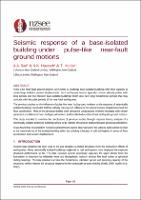| dc.contributor.author | Rad, Ali | |
| dc.contributor.author | Hazaveh, Nikoo | |
| dc.contributor.author | Holden, Tony | |
| dc.date.accessioned | 2023-02-21T01:18:13Z | |
| dc.date.available | 2023-02-21T01:18:13Z | |
| dc.date.issued | 2022-04-27 | |
| dc.identifier.uri | https://repo.nzsee.org.nz/xmlui/handle/nzsee/2486 | |
| dc.description.abstract | Pulse-Like Near-fault ground motions are known to challenge base-isolated buildings with their capacity to create large isolation system displacements. Such earthquake records typically contain velocity pulses with long periods and thus threaten base-isolated buildings which also have long fundamental periods that may coincide with the pulse periods of the near-fault earthquakes.
The previous studies on the influence of pulse-like near fault ground motions on the response of seismically isolated buildings concluded that the velocity pulse period influences the seismic isolator displacement and the floor acceleration. Most of the previous studies were conducted using ground motions simulated with certain parametric conditions of near-fault ground motions and/or a limited number of real earthquake ground motions.This study intended to examine the conclusions of previous studies through response history analysis of a seismically isolated prototype building using a large number of real near-fault earthquake ground accelerations. It was found that no consistent resonance phenomenon can be observed when the velocity pulse period is close to the natural period of the isolated building when the building is located in soft soil regions in terms of floor acceleration and isolator displacement. | |
| dc.language.iso | en | |
| dc.publisher | New Zealand Society for Earthquake Engineering | |
| dc.relation.ispartofseries | 2022;68 | |
| dc.subject | Advancements in structural and geotechnical design and assessment | |
| dc.title | Seismic response of a base-isolated building under pulse-like near-fault ground motions | |
| dc.type | Article | |

